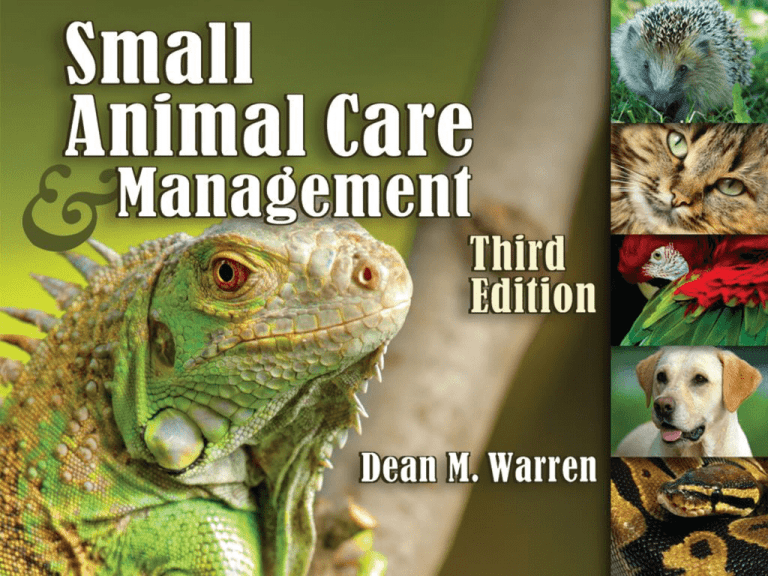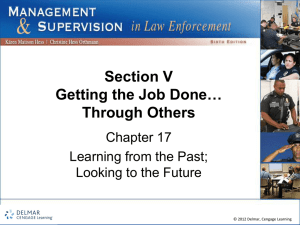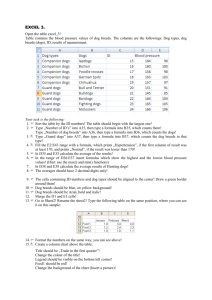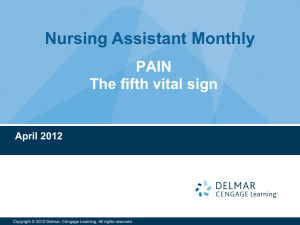
Copyright 2010 Delmar, Cengage Learning. All Rights Reserved.
1
CHAPTER
7
Dogs
Copyright 2010 Delmar, Cengage Learning. All Rights Reserved.
2
History of the Dog
• Probably first domesticated animal
~10,000 years ago
• Many dogs descended from the wolf
– These dogs roamed in packs
– Eventually found it easier to get food from
humans
– Humans began to depend on the dog
– Modern dog evolved from selected breeding
Copyright 2010 Delmar, Cengage Learning. All Rights Reserved.
3
History of the Dog
• Ancestors of the dog lived 40-50 million
years ago.
– Miacis
– Small carnivorous animals that looked more
like a weasel than a dog
– Lived in trees
Copyright 2010 Delmar, Cengage Learning. All Rights Reserved.
4
History of the Dog
• Tomarctus
– Considered the “father” of modern dogs.
– Body built for speed and endurance
– Was a hunter
– Looked much like the modern dog: today’s
dog retains much of the Tomarctus’
anatomical features
Copyright 2010 Delmar, Cengage Learning. All Rights Reserved.
5
History of the Dog
Today, 7 main groups
and 155 breeds
Copyright 2010 Delmar, Cengage Learning. All Rights Reserved.
6
7 Groups of Dogs
1.
2.
3.
4.
5.
6.
7.
The Sporting Group
The Hound Group
The Terrier Group
The Working Dog Group
The Herding Group
The Toy Group
The Non-Sporting Dog Group
Copyright 2010 Delmar, Cengage Learning. All Rights Reserved.
7
1-The Sporting Group
• Developed to help hunters pursue game
• Breeds
–
–
–
–
–
–
–
–
–
Pointer
German Shorthaired Pointer
German Wirehaired Pointer
Labrador Retriever
English Setter
Irish Setter
Brittany
English Springer Spaniel
American Cocker Spaniel
Copyright 2010 Delmar, Cengage Learning. All Rights Reserved.
8
2-The Hound Group
• One type hunts by scent, the other sight
• Breeds
–
–
–
–
–
–
–
–
–
Afghan Hound
Basset Hound
Beagle
Black and Tan Coonhound
Bloodhound
Dachshund
American Foxhound
Greyhound
Norwegian Elkhound
Copyright 2010 Delmar, Cengage Learning. All Rights Reserved.
9
3-The Terrier Group
• Two subgroups: (1) Long-legged, large breeds
and (2) short-legged, small breeds
• Breeds
–
–
–
–
–
–
–
–
–
Airedale Terrier
Bedlington Terrier
Border Terrier
Bull Terrier
Dandie Dinmont Terrier
Fox Terrier
Miniature Schnauzer
Skye Terrier
Welsh Terrier
Copyright 2010 Delmar, Cengage Learning. All Rights Reserved.
10
4-The Working Dog Group
• Developed to labor or work for humans
• Breeds
–
–
–
–
–
–
–
–
–
–
–
Alaskan Malamute
Boxer
Doberman Pinscher
Great Dane
Great Pyrenees
Standard Schnauzer
Rottweiler
Saint Bernard
Samoyed breed
Siberian Husky
Komondor
Copyright 2010 Delmar, Cengage Learning. All Rights Reserved.
11
5-The Herding Dog Group
• Developed to aid livestock herders with
livestock
• Breeds
–
–
–
–
–
–
Collie
Border Collie
German Shepherd
Old English Sheepdog
Shetland Sheepdog
Welsh Corgi
Copyright 2010 Delmar, Cengage Learning. All Rights Reserved.
12
6-The Toy Dog Group
• Developed as house pets and companions
• Breeds
– Chihuahua
– Italian Greyhound
– Manchester Terrier
– Pekingnese
– Pug
– Yorkshire Terrier
– Shih Tzu
Copyright 2010 Delmar, Cengage Learning. All Rights Reserved.
13
7-The Non-sporting Dogs
• Developed as companions
• Breeds
– Boston Terrier
– Bulldog
– Dalmatian
– Lhasa Apso
– Poodle
Copyright 2010 Delmar, Cengage Learning. All Rights Reserved.
14
The Miscellaneous Class
• American Kennel Club recognizes five breeds
where interest exists
– May compete in obedience trials, earn obedience
titles, and compete in conformation shows but not
earn championship points
– Continued interest may earn entrance to regular class
• Breeds
– Jack Russell Terrier
– Tibetan Mastiff
Copyright 2010 Delmar, Cengage Learning. All Rights Reserved.
15
The Hybrid or “Designer” Breeds
• Produced by crossing purebred dogs of
two different breeds
• Common hybrids
– Schnoodle: Schnauzer and poodle
– Goldendoodle: Golden retriever and poodle
– Labradoodle: Labrador retriever and standard
poodle
– Puggle: Female beagle and male pug
– Poochin: Poodle and Japanese chin
Copyright 2010 Delmar, Cengage Learning. All Rights Reserved.
16
Basics of Dog Feeding
• Commercial foods are fast and convenient
• Special groups need special feeding
– Pregnant and lactating females: More food,
more frequently
– Puppies: Puppy food in amount for breed
– Older dogs: Need protein and nutrients
• Other feeding suggestions
– Hard-boil or cook eggs before feeding
– Take care with bones
Copyright 2010 Delmar, Cengage Learning. All Rights Reserved.
17
Guidelines for Dog Exercise
• Avoid strenuous exercise for 2 hours after
dogs have eaten large meals
• Have dogs get physical exams
• Condition dogs for strenuous exercise
• Be alert to signs of dogs’ fatigue
Copyright 2010 Delmar, Cengage Learning. All Rights Reserved.
18
Methods of Dog Training
• Basic training
– Five basic commands starting as puppy
– Rely on voice, avoid hitting or threatening
• House-training
– Praise and scold appropriately
– Consider paper training
• Obedience training
– Start with short sessions, work longer
– Use proper equipment properly
Copyright 2010 Delmar, Cengage Learning. All Rights Reserved.
19
Basics of Dog Grooming and Care
•
•
•
•
•
Hair coats: Brush daily, check for mats
Bathing: Only as needed with dog soap
Nails: Trim occasionally
Ears: Clean monthly, no sharp objects
Eyes: Use eyewash solution, keep free of
irritants, rely on veterinary assistance
• Teeth: Clean once or twice a week
Copyright 2010 Delmar, Cengage Learning. All Rights Reserved.
20
Infectious Dog Diseases
• Caused by pathogenic microorganisms
able to invade and grow in living tissue
• Examples
– Canine distemper
– Infectious canine hepatitis
– Leptospirosis
– Canine parvovirus infection
– Infectious tracheobronchitis
– Rabies
Copyright 2010 Delmar, Cengage Learning. All Rights Reserved.
21
Noninfectious Dog Diseases
• Caused by physical injuries or genetic
defects or are noncontagious diseases
• Examples
– Heart disease
– Cataracts
– Glaucoma
– Progressive Retinal Atrophy (PRA)
– Cherry eye
– Hip dysplasia
Copyright 2010 Delmar, Cengage Learning. All Rights Reserved.
22
Fungal Dog Diseases
• Ringworm
– One of most common fungal diseases
– Fungal organisms in dogs and cats, soil, and
wild rodents
• Systemic fungal infections
– Blastomycosis
– Histoplasmosis
– Coccidioidomycosis
Copyright 2010 Delmar, Cengage Learning. All Rights Reserved.
23
Internal Dog Parasites
•
•
•
•
•
Roundworms
Hookworms
Whipworms
Tapeworms
Heartworms
Copyright 2010 Delmar, Cengage Learning. All Rights Reserved.
24
External Dog Parasites
•
•
•
•
•
Fleas
Ticks
Lice
Mites
Chiggers
Copyright 2010 Delmar, Cengage Learning. All Rights Reserved.
25
Poisonings
•
•
•
•
•
•
•
Insecticides
Plants
Household chemicals
Herbicides
Medications
Metal poisonings
Antifreeze
Copyright 2010 Delmar, Cengage Learning. All Rights Reserved.
26







